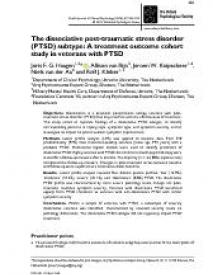The dissociative post-traumatic stress disorder (PTSD) subtype : A treatment outcome cohort study in veterans with PTSD
Abstract
Objectives
Dissociation is a prevalent phenomenon among veterans with post-traumatic stress disorder (PTSD) that may interfere with the effectiveness of treatment. This study aimed to replicate findings of a dissociative PTSD subtype, to identify corresponding patterns in coping style, symptom type, and symptom severity, and to investigate its impact on post-traumatic symptom improvement.
Methods
Latent profile analysis (LPA) was applied to baseline data from 330 predominantly (97%) male treatment-seeking veterans (mean age 39.5 years) with a probable PTSD. Multinomial logistic models were used to identify predictors of dissociative PTSD. Eighty veterans with PTSD that commenced with psychotherapy were invited for a follow-up measure after 6 months. The majority (n = 64, 80% response rate) completed the follow-up measure. Changes in post-traumatic stress between baseline and follow-up were explored as a continuous distal outcome.
Results
Latent profile analysis revealed four distinct patient profiles: ‘low’ (12.9%), ‘moderate’ (33.2%), ‘severe’ (45.1%), and ‘dissociative’ (8.8%) PTSD. The dissociative PTSD profile was characterized by more severe pathology levels, though not post-traumatic reactions symptom severity. Veterans with dissociative PTSD benefitted equally from PTSD treatment as veterans with non-dissociative PTSD with similar symptom severity.
Conclusions
Within a sample of veterans with PTSD, a subsample of severely dissociative veterans was identified, characterized by elevated severity levels on pathology dimensions. The dissociative PTSD subtype did not negatively impact PTSD treatment.
Practitioner points
- The present findings confirmed the existence of a distinct subgroup veterans that fit the description of dissociative PTSD.
- Patients with dissociative PTSD subtype symptoms uniquely differed from patients with non-dissociative PTSD in the severity of several psychopathology dimensions.
- Dissociative and non-dissociative PTSD patients with similar post-traumatic severity levels showed similar levels of improvement after PTSD treatment.
- The observational design and small sample size caution interpretation of the treatment outcome data.
- The IES-R questionnaire does not assess all PTSD DSM-IV diagnostic criteria (14 of 17), although it is considered a valid measure for an indication of PTSD.
Geachte bezoeker,
De informatie die u nu opvraagt, kan door psychotraumanet niet aan u worden getoond. Dit kan verschillende redenen hebben,
waarvan (bescherming van het) auteursrecht de meeste voorkomende is. Wanneer het mogelijk is om u door te verwijzen naar de bron
van deze informatie, dan ziet u hier onder een link naar die plek.
Als er geen link staat, kunt u contact opnemen met de bibliotheek,
die u verder op weg kan helpen.
Met vriendelijke groet,
Het psychotraumanet-team.
In: British Journal of Clinical Psychology, ISSN 0144-6657; eISSN 2044-8260 | 57 | 2 | June | 203-222
http://doi.org/10.1111/bjc.12169


